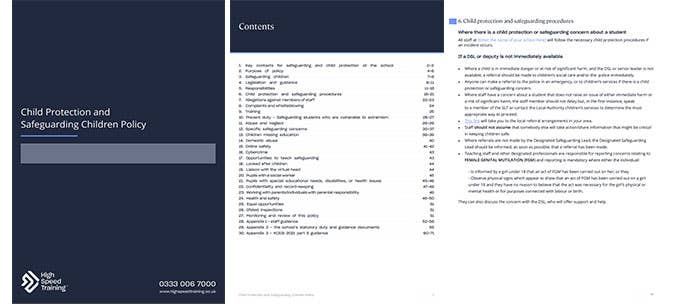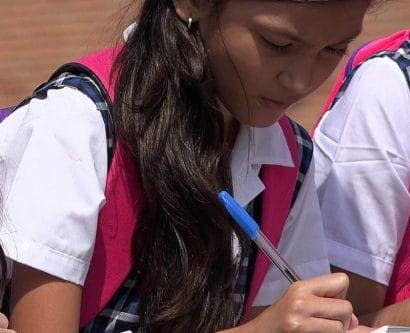Creating a Safeguarding Policy – Example Template for Schools
Protecting the welfare of children is your school’s number one priority, and it must demonstrate its commitment to this responsibility with a written safeguarding policy.
A safeguarding children policy is essential for showing compliance with safeguarding law and for giving staff guidance on the school’s expectations. It also acts as a trust signal for parents, carers, and guardians of children. They’ll appreciate a thorough breakdown of everything the school does to keep children safe.

This policy needs to be comprehensive and can therefore be time-consuming to produce. That’s why we’ve worked together with a designated safeguarding lead to create a safeguarding policy template. You can use it in almost any school and adapt certain sections to your specific safeguarding measures where needed.
Throughout this guide, you’ll find a summary of what sections the policy template contains.
What is a Safeguarding Children Policy?
A school safeguarding policy details all the procedures that everyone must follow to protect children’s wellbeing. It is a vital document that all education settings must produce to demonstrate compliance with safeguarding statutory guidance, particularly Keeping Children Safe in Education and Working Together to Safeguard Children.
The scope of safeguarding is wide, as children are susceptible to more risks than ever before. Safeguarding policies in schools must consider all safeguarding risks, from abuse and neglect, through online safety and extremism, to FGM and child exploitation.
Staff who work with children will receive safeguarding training that explains their duties for minimising risk, and the policy will summarise these duties. It will confirm that everyone in the school knows what to do if a safeguarding concern arises and how to act in the best interest of the child.

A thorough safeguarding policy will ensure there’s no uncertainty in the school about what must be done to protect children.
What Should a School Safeguarding Policy Cover?
Although the specific details vary from school to school, all education settings must cover the same essential safeguarding procedures in their policy. Our template includes all of these with room to tailor where needed.
The key sections required in a safeguarding policy include the following:
- A policy statement. This acknowledges the school’s responsibilities for safeguarding children and summarises what they will do.
- Summary of safeguarding children, which demonstrates an understanding of how broad safeguarding is and what risks the school will aim to mitigate.
- Legislation and guidance. This section should discuss the various legislative provisions and statutory guidance documents that inform the school’s safeguarding procedures and policy.
- Overview of responsibilities in the school. This section will summarise the duties that staff must fulfil to protect children.
- Child protection procedures, which should summarise the actions everyone will take, including whistleblowing, if they identify a safeguarding concern.
- How the school will safeguard students who are vulnerable to: extremism, child sexual exploitation, FGM and forced marriage, or trafficking, as well as those identified as “at risk”.
- Children missing in education. The school will acknowledge the importance of monitoring attendance and identifying potential signs of safeguarding concerns in unusual absences.
- Online safety and teaching safeguarding. This section should identify online safeguarding risks and what protocol are in place to mitigate these risks, such as filters and monitoring systems. It should also explain how the school’s curriculum includes teaching children about safeguarding risks (i.e. PSCHE lessons).
- Looked after children and liaising with virtual schools. These sections will acknowledge the specific issues around safeguarding looked after children and working with virtual schools.
- Children with SEN and disabilities, which will recognise the additional safeguarding challenges that SEN and disabled children may face.
- How the school will prevent and handle children harming other children, which includes peer-on-peer abuse, sexual abuse, and sexual harassment.
- Confidentiality and record keeping. The school must acknowledge how it will comply with data protection law when handling safeguarding information.
- Working with parents and others with parental responsibilities. This section should detail the importance of partnering with parents to establish a complete safeguarding process. It should also explain how parents will be made aware of and involved in any safeguarding procedures where possible.
- Health and safety, which identifies additional safety risks in the school. For example, school trips, work placements, and the presence of visitors and contractors.
- OFSTED inspection. Part of OFSTED inspections involves demonstrating that the school’s safeguarding arrangements are effective. The policy should therefore explain that the school is familiar with OFSTED’s current framework.
- Monitoring and reviewing the policy. Safeguarding guidance is subject to amendments over time and the school may even undergo changes that affect its procedures. The school should state who will review their policy and how often to reflect any changes.
- Key contacts. This section should list the contact information for key safeguarding staff. For example, the designated safeguarding lead, local authorities, and relevant support networks and organisations.
This list is not exhaustive, but highlights some of the key areas that policies must include in relation to safeguarding.

School Safeguarding Policy Template
Our school safeguarding policy template covers all of the above sections in thorough detail. It also provides an opportunity to amend certain sections to reflect your school’s specific procedures.
You can download a PDF copy for free below:

We produced this template together with a qualified designated safeguarding lead (DSL) and wrote it in such a way that it can be used in almost any school. However, your school’s own DSL should still review its contents to ensure it’s entirely relevant to your school’s procedures. They should also tailor the content where necessary.
Having a written safeguarding policy is essential in any education setting. By providing an overview of the school’s procedures for keeping children safe, a policy shows compliance with safeguarding law and reminds everyone of what they must do. Use our free template if you need help producing one, as it covers everything necessary for a comprehensive policy.
What to Read Next:
- What is a Designated Safeguarding Lead?
- How Can Schools Promote Positive Mental Health?
- Whistleblowing in Schools: Policy and Procedure
- Child Protection Photography Policy: Free Consent Form Template
- What is the Purpose of School Policies?
- What is Fabricated and induced Illness?
- How to Create an Effective Culture of Safeguarding in Schools
- Child Sexual Abuse: Guidance for Schools
- Safeguarding Flowchart: Procedure for Reporting Concerns
- Safeguarding Checklist for Schools
- Online Safeguarding Children Training Courses











